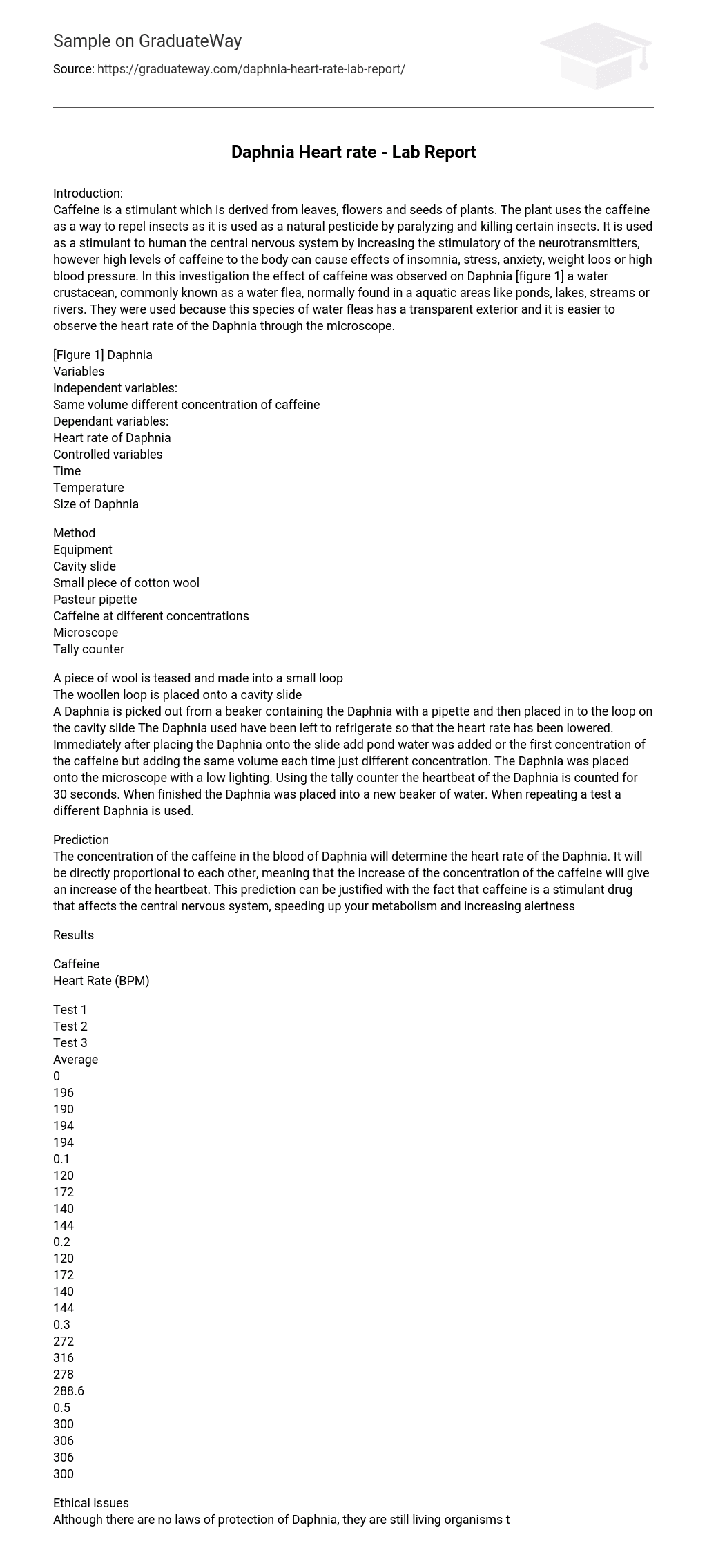Introduction:
Caffeine is a stimulant which is derived from leaves, flowers and seeds of plants. The plant uses the caffeine as a way to repel insects as it is used as a natural pesticide by paralyzing and killing certain insects. It is used as a stimulant to human the central nervous system by increasing the stimulatory of the neurotransmitters, however high levels of caffeine to the body can cause effects of insomnia, stress, anxiety, weight loos or high blood pressure. In this investigation the effect of caffeine was observed on Daphnia [figure 1] a water crustacean, commonly known as a water flea, normally found in a aquatic areas like ponds, lakes, streams or rivers. They were used because this species of water fleas has a transparent exterior and it is easier to observe the heart rate of the Daphnia through the microscope.
[Figure 1] Daphnia
Variables
Independent variables:
Same volume different concentration of caffeine
Dependant variables:
Heart rate of Daphnia
Controlled variables
Time
Temperature
Size of Daphnia
Method
Equipment
Cavity slide
Small piece of cotton wool
Pasteur pipette
Caffeine at different concentrations
Microscope
Tally counter
A piece of wool is teased and made into a small loop
The woollen loop is placed onto a cavity slide
A Daphnia is picked out from a beaker containing the Daphnia with a pipette and then placed in to the loop on the cavity slide The Daphnia used have been left to refrigerate so that the heart rate has been lowered. Immediately after placing the Daphnia onto the slide add pond water was added or the first concentration of the caffeine but adding the same volume each time just different concentration. The Daphnia was placed onto the microscope with a low lighting. Using the tally counter the heartbeat of the Daphnia is counted for 30 seconds. When finished the Daphnia was placed into a new beaker of water. When repeating a test a different Daphnia is used.
Prediction
The concentration of the caffeine in the blood of Daphnia will determine the heart rate of the Daphnia. It will be directly proportional to each other, meaning that the increase of the concentration of the caffeine will give an increase of the heartbeat. This prediction can be justified with the fact that caffeine is a stimulant drug that affects the central nervous system, speeding up your metabolism and increasing alertness
Results
Caffeine
Heart Rate (BPM)
Test 1
Test 2
Test 3
Average
0
196
190
194
194
0.1
120
172
140
144
0.2
120
172
140
144
0.3
272
316
278
288.6
0.5
300
306
306
300
Ethical issues
Although there are no laws of protection of Daphnia, they are still living organisms that need to be treated with reverence, keeping them exposed to environments that they are not naturally acquainted with would deem unethical, so putting them back into pond water when finished would be proper. It could be argued by animal rights or religious views that experimenting on any kind of living is wrong as they also probably feel pain, although they may not suffer in the same way as higher animals they should be correctly returned to their natural habitat after observation.
Risk assessment
Risks
Prevention
Caffeine Concentrations in eyes or spillages onto clothes
Caffeine concentrations could splash into the eyes causing irritation, this could be prevented by wearing goggles. Also to prevent close being damaged by spillages a lab coat should be worn. Microscopes
Heat from the microscope can be harmful to the Daphnia, keeping the brightness low won’t kill any Daphnia. Glass ware breaking
Handling any glassware for example beakers or petri dishes with care. Wearing goggles or a lab coat will help towards preventing any accidents.
Source of error
-Because we had to count the heart beat ourselves it is unreliable as we weren’t able to click fast enough or clicked one to many when there wasn’t a heartbeat or miss heartbeats all together. -Each time a different concentration of caffeine was added a different volume of distilled water was also added each time. As well as different volumes of caffeine. -A different Daphnia was picked out every time a new test was carried out, so they may have been different age/size/gender, this can cause different results. -The timing method was not precise each time a test was carried out as the 30 seconds was either just under or just over. -Because of handling the Daphnia from the beaker to the petri dish to a light under the microscope could put the Daphnia under pressure giving them a raised heart beat any way.
Conclusion
Our results show a curve of 0% concentration being higher than 0.1% and 0.2% concentration, this could be because of a source of error, as the graph shows a positive correlation of the increase of the caffeine percentage of concentration to the heartbeat of the Daphnia. The results did not fully match with the prediction made as the caffeine concentration % at 0.2 was less effective than 0.1, this may have been a human error, but other than that it seemed to support the prediction as the heart rate tends to increase from 0.2 onwards as there is a considerable increase from 0.2 to 0.3. With the sources of error affecting the results making them inaccurate, we could improve the reliability of the test by improving the count of the heartbeat of the Daphnia or using bigger animals so that the heart is easier and quicker to find. Doing trial runs or repeating the test more times could help towards the reliability of the test.





